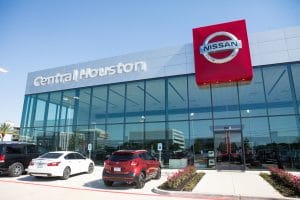
The Jupiter Spirit is anchored off the coast of California, filled with new Nissans that dealers can’t take.
A mile off the coast of Los Angeles, the Jupiter Spirit sat anchored, the big cargo ship sitting in limbo after a three-week journey from Japan, unable for five days to unload the 2,000 Nissan and Infiniti vehicles onboard because there was simply nowhere to put them.
As a result of the coronavirus pandemic, unsold new vehicles have piled up in dealer lots, in warehouses, in parking lots and pretty much anywhere they can be stored. Ironically, the situation would have been far worse had auto production in the U.S. not been halted in mid-March. But shipments of vehicles from some parts of the world, notably Japan and Korea, have continued to flow.
“Dealers aren’t really accepting cars and fleet sales are down because rental-car and fleet operators aren’t taking delivery either,” John Felitto, a senior vice president for the U.S. unit of Norwegian shipping company Wallenius Wilhelmsen told the Bloomberg news service. “This is different from anything we’ve seen before. Everyone is full to the brim.”
(Sales may be slumping, but zero-percent deals are at all-time high.)
The inventory situation could have been yet worse but for the steps automakers and dealers have taken to try to prop up demand. That includes hefty incentives that, according to J.D. Power, currently average over $4,000 a vehicle – an industry record – with the givebacks on full-size pickups running to $7,300.
Meanwhile, dealers in a number of states have found ways to work around pandemic lockdowns, many now taking orders online and using contactless delivery processes.

Nissan dealers, among others, aren’t selling many cars, creating a storage problem for imported vehicles.
“It has been breathtaking to me to see how fast that has happened,” Jim Farley, Ford’s chief operating officer, said during a Thursday media webinar.
Nonetheless, the inventory glut isn’t going to be resolved any time soon, industry experts caution, especially with manufacturers getting ready to put their U.S. assembly plants back into operation.
Automakers were expected to report April sales numbers on Friday. Preliminary estimates called for a year-over-year downturn of somewhere between 45 and 52%, sales likely to come in for the month well below anything seen during the Great Recession. At an annualized rate, that would work out to something below 8 million, or less than half the 17.1 million cars, trucks and crossovers sold in the U.S. during all of 2019.
On the plus side, “We have experienced four weeks in a row of growth from (the late-March) trough,” Tyson Jominy, head of the Power network, said during a media conference call on Tuesday, “We are in the midst of the recovery, so, from here we would expect sales to continue to improve.”
(U.S. new car market showing signs of recovery – but faces a long slog, big losses for makers.)
But what Jominy calls a recovery is a matter of perspective. Power’s latest forecast still sees a significant trough in demand through early to mid-summer and, for the full year, the research firm cautioned that sales could come in as low as 12.7 million, the lowest figure seen in nearly a decade. And that doesn’t necessarily account for what might happen were there to be a second round of coronavirus outbreaks next autumn or winter triggering new lockdowns and a further hit to an already battered economy.
Even if that doesn’t happen, not everyone is convinced the U.S. market will bounce back any time soon.
“People have lost their jobs or fear losing their jobs and they’re certainly not going to spend

Ford COO Jim Farley said the changes in the sales structure for new cars during the pandemic has been “breathtaking.”
money on large-scale purchases like an automobile,” said Joe Phillippi, head of AutoTrends Consulting.
Even with the modest rebound underway, it would take some time to really bring down the current glut of automotive inventory, analysts like Phillippi contend. There likely will be a few exceptions, notably large pickups. Demand remained surprisingly consistent, even during the depth of the overall sales trough – at just around 10% below what had been forecast pre-pandemic. In the coming weeks dealers very well could see some spot shortages of the most popular truck configurations, according to Power’s Jominy.
The question, however, is what happens when plants do get up and running. That’s clearly something the industry would like to occur sooner, rather than later, if for no other reason than because manufacturers only make money once a car rolls off the assembly line and heads to dealership.
The first few plants are already gearing back up. But a broad-scale effort continues to get pushed back. In recent days, Volkswagen, Kia, Tesla and other manufacturers have announced start-up delays. So have Detroit’s Big 3 who began the week targeting May 18. That schedule now could slip through at least May 28 due to Michigan Gov. Gretchen Whitmer’s decision to extend the state’s pandemic lockdown.
(U.S. new vehicle sales expected to drop by half in April.)
But the industry is all but certain to be in widespread production by early to mid-summer. Both Ford and Toyota officials have made clear they will ramp operations up slowly, likely taking a month or more before reaching anything close to pre-pandemic levels. But if consumer demand doesn’t keep pace, the glut of unsold inventory will then only grow. And the concern is that this will force manufacturers to further increase incentives already at record levels. That, in turn, would further cut into margins, threatening to repeat the financial crisis the industry faced during the Great Recession.
